
| Home | FAQs | Rules | Archives | Articles | Jobs | Links | KWHSS | OSCAR | SCA.org |
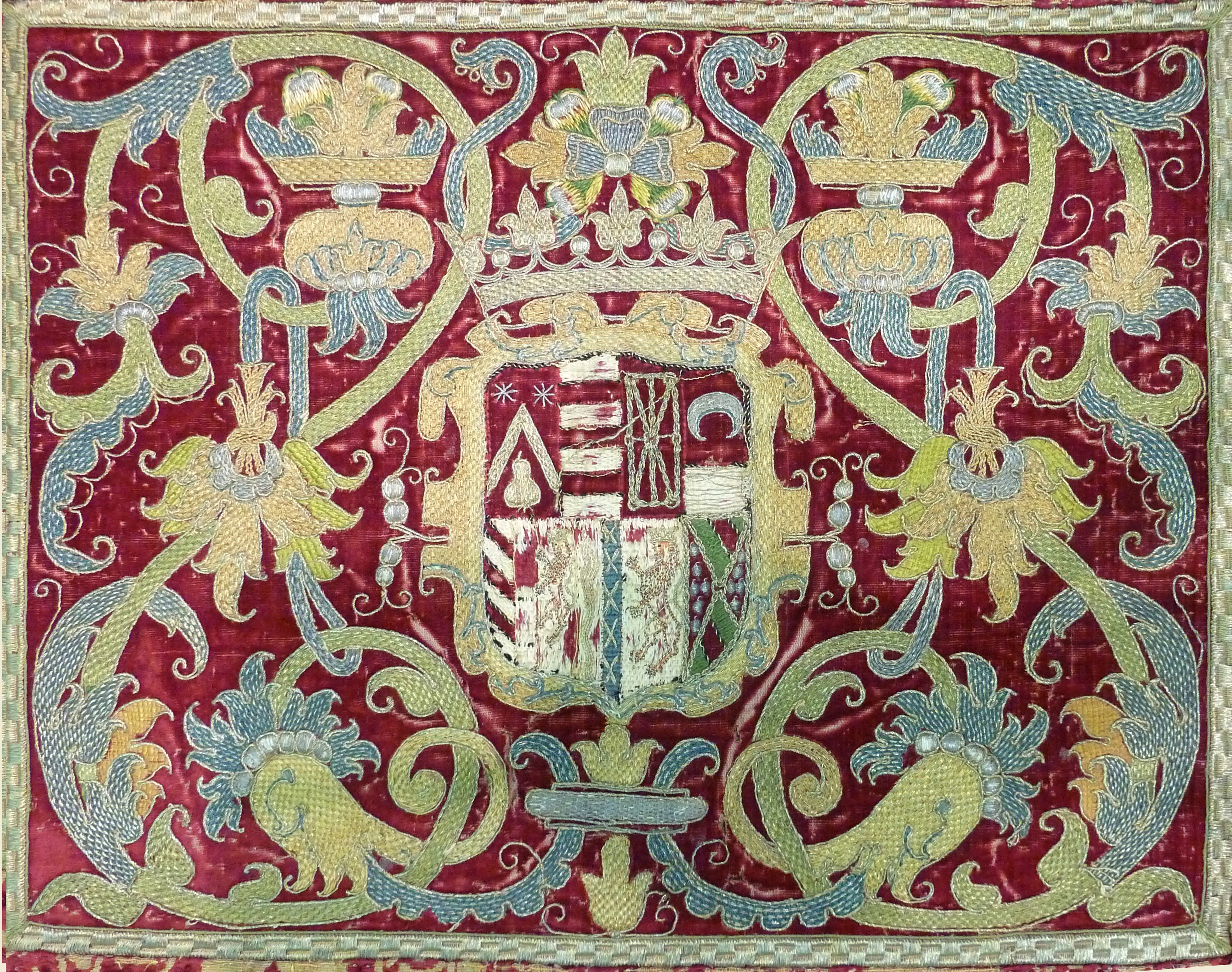 | LINEAGE OF DALMATIC ARMSAnalysis by Melinda Sherbring |
INTRODUCTION
The front and back of a dalmatic in the collection of the Los Angeles County Museum of Art (M.57.9) displays an elaborate shield of many quarters on both front and back, and a unquartered shield on each sleeve. The museum identifies the garment as Spanish, 16th century. A full-length photo is available on the web at http://collections.lacma.org/node/232520 . Whose arms are they? Ultimately, this researcher found no clear indication of who this armory could legitimately represent, but the quest provided some insights into who the players might be.
The rules of heraldry should help identify the family affiliations of the armiger, but ultimately not enough of the armory was identified to allow a person to be identified. This paper documents the information found and the questions asked, even if they did not ultimately lead to a specific person or family. But it does provide a glimpse into the history of Spain at that time. Both heraldic and genealogical sources were consulted in the course of this investigation.
THE GARMENT AS A WHOLE
A dalmatic is a liturgical vestment shaped as a long, wide sleeved tunic outer garment with open sides. It is worn by a Roman Catholic1 deacon or, rarely, bishop. It is colored to match the liturgical color of the day. The liturgical colors are those worn for particular feast days, and throughout the church year. The color red is worn for feasts of the Lord's passion, blood, and cross, Palm Sunday, Pentecost, and feasts of martyrs.
LACMA's dalmatic is made of deep red voided velvet. The pale yellow woven background contrasts with a large-figure design of red velvet pomegranates accented with additional looped silver thread pile areas. Individual loops of silver thread dot the larger red velvet areas at regular intervals. The silver threads are visible in the woven areas, usually part of the weave and disguised by yellow silk, but often lying loose on the surface as long floating threads. The long floats appear to be the result of the wear and tear of age, rather than intentional.
The long garment is shaped like a T, with a slight flare. The garment body was cut as two long rectangular panels with a slight bit of shoulder shaping. The pieces are joined at the shoulders with pomegranates facing upwards on each side. Each sleeve is a square, folded at the shoulder, attached to the upper part of the joined body rectangles. The only seam on the sleeve is the one attaching it to the main garment; the lower edges are not joined. Long triangles of the voided velvet fabric are attached on either side of the central rectangles, from armholes to hem. All vertical garment seams are covered with embroidered red velvet ribbon that has since faded to a pale pink. As laid out on the table, the grain of the fabric of the body pieces runs vertically, and the sleeves are placed horizontally.
The neckline is a shallow oval for the head to go through, bound with a ribbon of red silk fabric. The lining is a salmon pink tabby-woven linen fabric. The edges are outlined with a silver passementerie trim. All the trim is on the outside; it does not bind the garment edges. There are also two dangling knotted buttons on each sleeve, with a cord on the matching edge to loop over the buttons. The cord may be finger-loop braided.
The garment is 44" from shoulder to hem, and 57" from the end of one sleeve to the other. On a 5'7" tall person, this puts the garment hem just below knee level, and the sleeves from wrist to wrist on outstretched arms.
A short distance above the hem on the front and back is a large panel of plain red velvet, closely matched in color to the voided velvet. The panel is embroidered with vines sprouting colorful leaves and fanciful flowers worked in gold, flanking a shield with several quarterings.
Attached at the hem of each sleeve is another panel of the same red velvet. It is the full width of the sleeve and half the height. It is embroidered with an unquartered shield surrounded by fanciful vines.
Both sets of shields are dwarfed in their respective panels by the fantastical scrolls and foliage surrounding it. There is a crown above the multi-quartered shield, but not the sleeve's shield. Both designs are flanked by two flowers at the center of a leafy spiral that strongly resemble the heraldic depiction of a grenade. It is a weapon depicted as a globe with tongues of flame issuant from one end.
Spanish Kingdom of Granada has as its symbol the pomegranate. The use of pomegranates in the figured design, and grenades in the embroidery may imply an affiliation of some kind with Granada.
| Part of the decoration around the shield that may be a grenade. | An heraldic grenade. |
 |
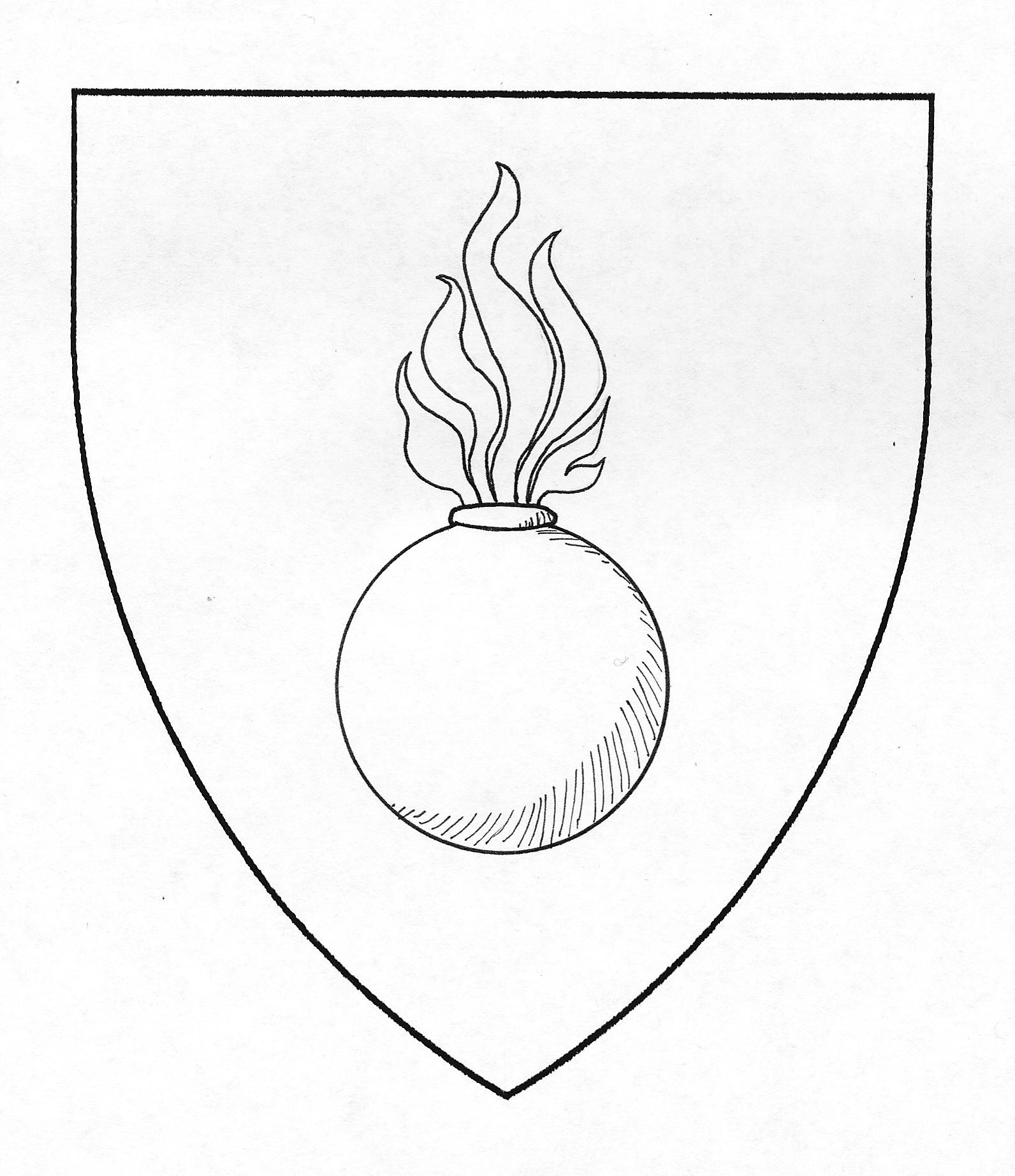 |
| Heraldic grenade art provided by Bruce Miller. |
THE SLEEVE ARMORY
|
Each sleeve panel of red velvet has a shield that can be blazoned "Gules, three palm fronds enfiled of a crown; in base the word 'Victoria' Or." On one side, the word appears to be "Victora". The other sleeve is similar, but the word on the shield is spelled is "Victori." In both cases, the T and the O are superimposed to shorten the space taken by the word. The first I has a complex knot dotting it. The left upright of the final A has a similar knot above it, indicating that may also serve as the letter I. The word then becomes "Victoria", a Spanish word that which is "Victory" in English. The gold twist forming the right side of the final A appears to have gone missing on the "Victori" sleeve. Palm fronds are a symbol of victory, and a crown usually represents nobility. Martyrs of the church are identified in paintings by carrying a palm frond. While there are several allusions present, no explicit Church-symbolic connections were found between the sleeve armory and the use of this garment during Pentecost or Palm Sunday. But it would clearly be appropriate to wear this garment on that occasion. | 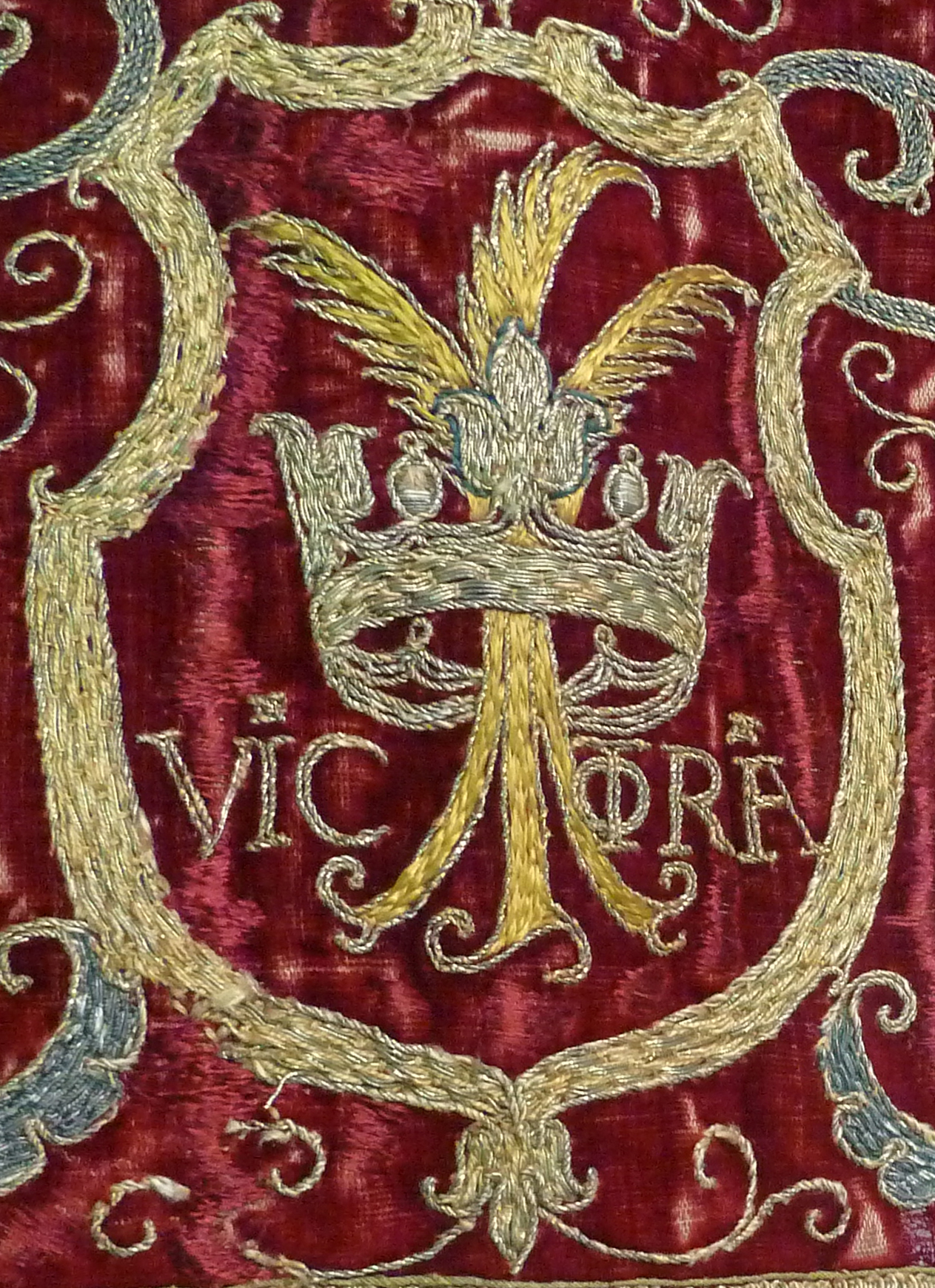 |
THE MANY-QUARTERED ARMORY
The coat of arms on this dalmatic identifies a person or family - either the person wearing the garment, or, more likely, the patron of that church.
 |
Above the shield is a crown, and above that is a floral figure with silver ribbons entwined with the flanking vines. The floral figure appears to be a silver partial rose placed atop a spray of gold honeysuckle that alternates florets and buds. The crown atop the achievement has eight large points each topped with a three-lobed motif alternating with short points topped with pearls. The three-lobed motif could represent strawberry leaves, the top half of a fleur de lis, or the flowering part of a honeysuckle. Three whole points and two half-points are visible. |
A coronet of strawberry leaves without pearls represents a Duke in Spain as well as throughout Europe.2 The crown with leaves and pearls, as drawn here, is similar to the former heraldic Crown of Spanish and Castilian monarchs. However, while the arms of the Kingdoms of Navarre and Léon are included on this shield, none of the rest of the armory is specifically royal. In particular, the arms in the upper left corner, which indicate the patrilineal descent of the owner of the arms, are not only not royal, but they are rather obscure. That indicates that this patron is more likely a duke than royalty.
The shield on the front and back panels is composed of at least 8 parts, called "quarters." Conventionally, the strip of arms on the top represent the patron's father's lineage, the strip along the bottom represents his mother's lineage.3 The left-most arms on the top strip represent the arms of the patron's father's grandfather on his father's side. The third arms on the top strip represent the arms of the Duke's father's grandfather on his mother's side - King of Navarre.
SOURCES AND CAVEATS
Armorial manuscripts are a useful tool when researching coats of arms. They show pictures of armory with the name of the person who bears those arms at the time the manuscript was created. They thus prove that the coat of arms existed at that time, and provide guidance to the family line being represented. But assignment of a set of arms to a particular person in an armorial manuscript does not mean that that person is the one represented by those arms in another context - the other context might be either an ancestor or a descendant of the person named. Armorial manuscripts will be referenced here by the initials of the title. These are decoded in the Armorial Manuscripts part of the bibliography at the end of the paper.
In the late 1800s, a Dutch heraldist, Johannes Baptiste Rietstap, compiled a monumental list of coats of arms and the family associated with them, from continental Europe and a lesser number from the British Isles. The work, the Armorial Général, with some 50,000 entries, is probably the most complete such list made. It is arranged alphabetically by family surname. To find the family represented by a particular coat of arms, one needs an "ordinary." Comte Théodore de Renesse created an ordinary to Rietstap's work. All of the above were consulted in the course of this investigation.
Note that the singleton and conjectured arms in the following paper have been created from the original photos via Photoshop. In some cases, missing threads have been filled in. This may have introduced errors, but the resulting photos are consistent with the identifications in the text.
The shields are here described in the specialized jargon of heraldry, called a "blazon." The rules of English blazon will not be covered here, but can be found fairly easily. The quarters are numbered left to right, first the top row (father's side) then the bottom row (mother's side).
A note on Spanish naming practices is of use here, as well. Prior to the modern age, a child's full name includes both the father's and mother's surnames, of the form "<father's surname> y <mother's surname>". A man will keep that surname throughout his life. A woman's surname changes when she marries, to "<husband's surname> y <father's surname>". This may help identify possible people, based on the armory.
It is unclear if a royal connection might influence the armory or even the names to be different from the normal ordering. For this analysis, it is assumed that there is no "royalty effect." Further research on that topic may be productive.
QUARTERED ARMS
| Armiger | |
| From dalmatic side 1 | From dalmatic side 2 |
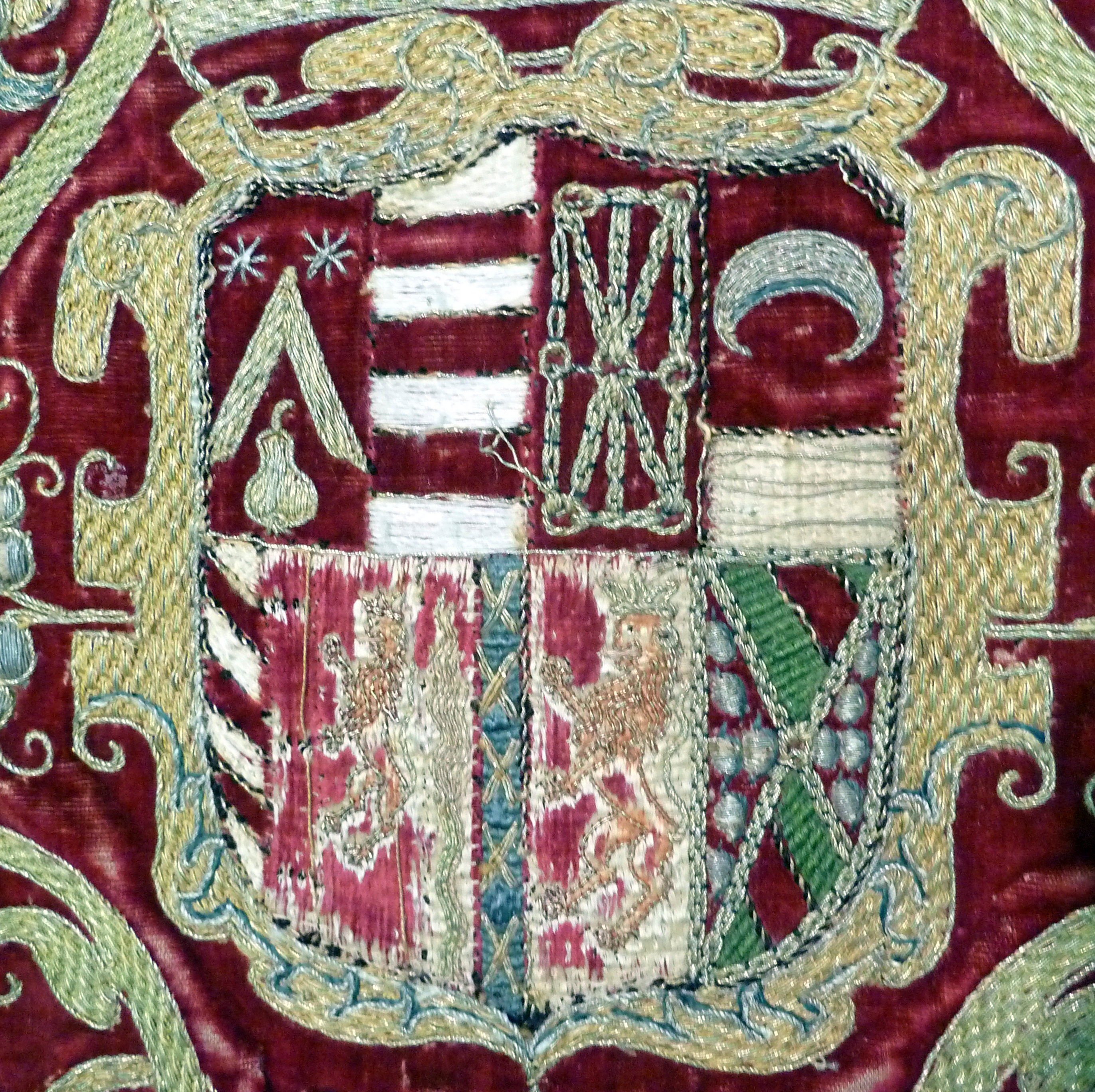
| 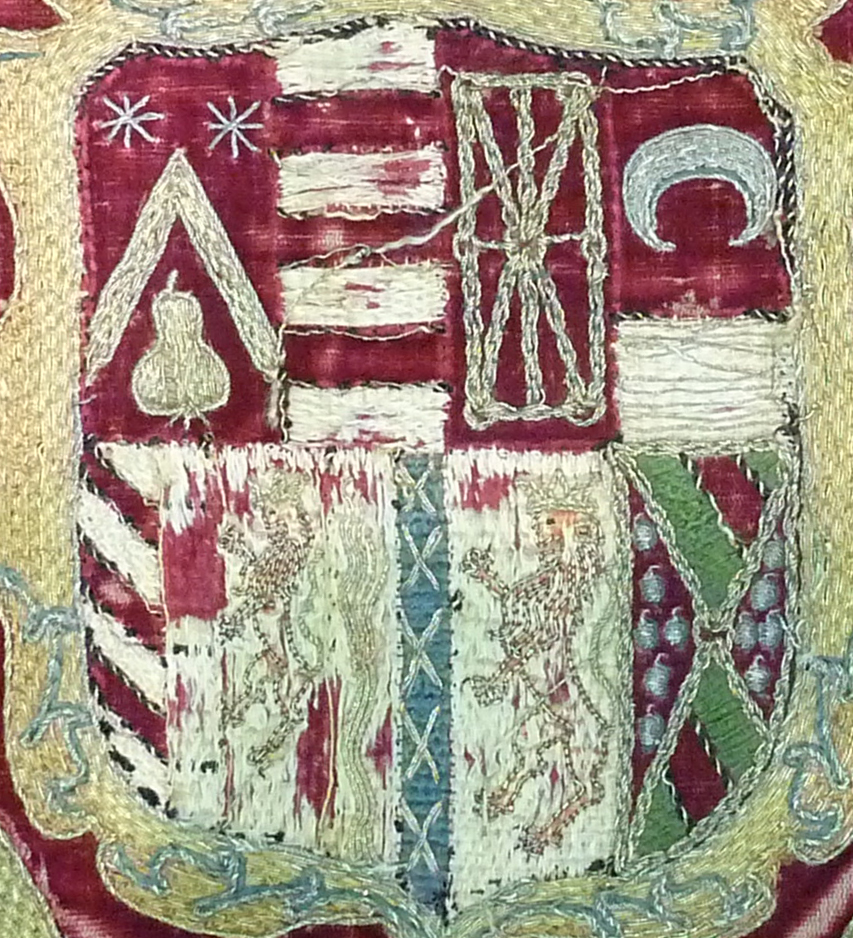
|
ARMORY OF THE FATHER'S SIDE
| 1- Family 1 ? Zapera? | 2- Family 2 Silveira, Pestana, Leitan, or de Croy | 3- Kingdom of Navarre | 4- Family of de Luna |
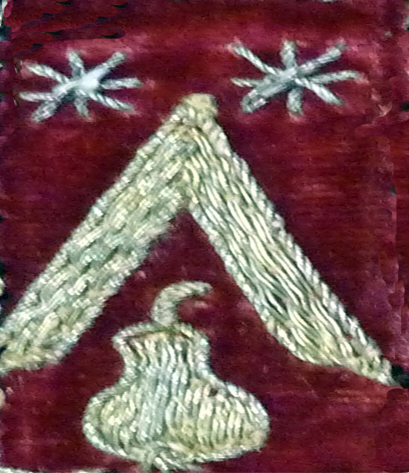
| 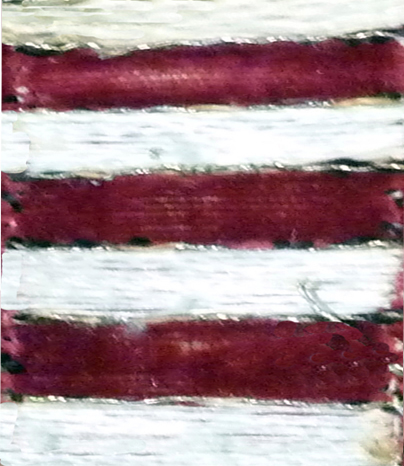
| 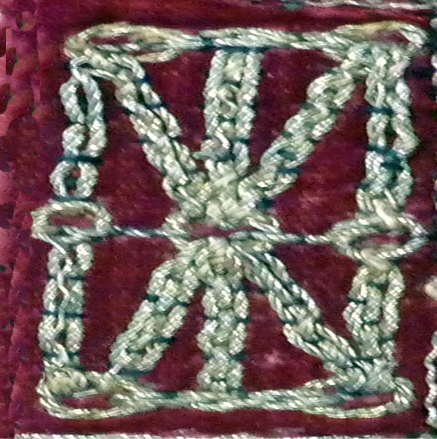
| 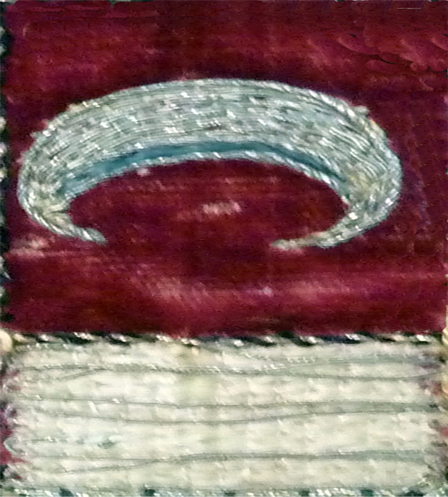
|
| Armiger's Father's Father (Conjectured arms ... ?Zapera y ??) | Armiger's Father's Mother (Conjectured arms ... Navarre y de Luna) | ||
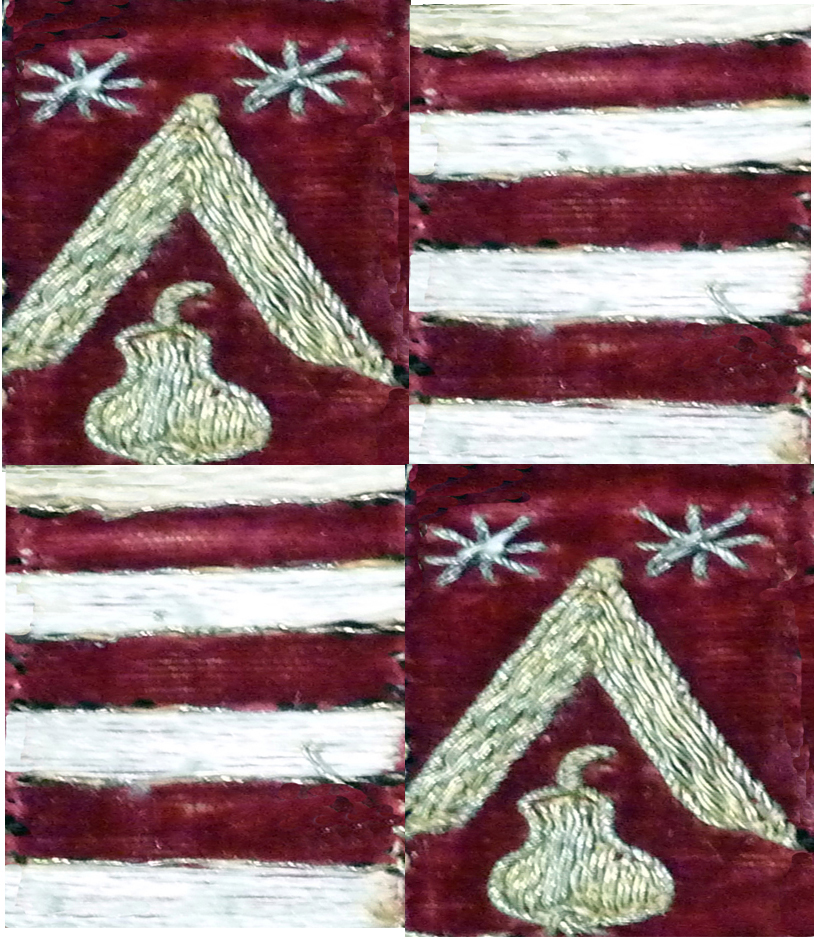
| 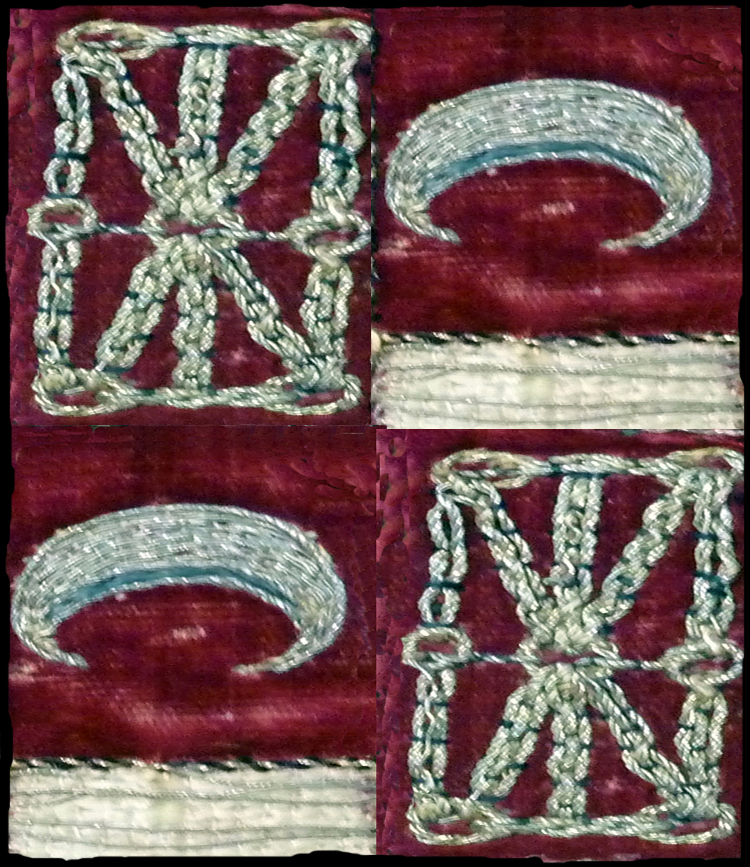
| ||
| Father's arms (?Zapera? y ?Navarre?) | |||

| |||
None of the conjectured arms have been found so far on monuments or in armorial manuscripts.
1- Father's Grandpa: (Gules, a chevron Or between two molets of 8 points argent & a pear Or) Per Rietstap, the Spanish family of Zapera bears "De gueules au chevron d'or acc. on chef de deux croix pattées au pied fichée d'argent et on point d'un poire d'or" (English blazon: "Gules, a chevron Or between two crosses pattée fitchy at the foot argent and a pear Or). That is not precisely the armory seen here, but close enough to suggest that there may be a familial connection. Renesse does not list any other surname associated with arms containing a chevron and a pear. A web search of the last points to a South American tribe. So if this is the correct family, no members have made sufficient impact on history to be recorded in resources accessible to the internet.
2- Father's Grandma: (Argent, three bars gules) These arms have a problem opposite the preceding ones. There are too many possible families, and no way to choose one over another as being relevant to this quartered coat.
- Per LNPA, f. xiiij, and LAM p. 168 (f. 68), these are the arms of Ssilveira = Silveira.
- Per LNPA, f. xxii verso, and LAM, p. 146 (f. 103), these are the arms of Pestana.
- Per LNPA, f. xxvi, and LAM, p. 63, these are the arms of Leitan = Leitão.
- House of Croy or Duc de Croÿ - designed by Charles de Croÿ, for Adrien de Montigny, "Armoiries d'argent à trois fasces de geules, l'écu sommé d'une couronne d'or", or in English blazon, "Argent, three bars gules, the shield surmounted by a crown Or."
- Also a quartering in the 4Armorial équestre Toison d'or for Antoine de Croÿ
3- Father's Grandpa - (Gules, an escarbuncle of chain within an orle of chain Or) Arms of the Kingdom of Navarre.
4- Father's Grandma - (Gules, a crescent inverted and base argent), her father's arms. They are the arms of the de Luna family. They appear in AdlC, folio 162: Don Pedro de Luna, Count of Morata5 = Pedro Manrique de Luna y de Urrea, count of Morata de Jalón (1539-1554), Viceroy of Aragon.
GENEALOGY OF THE FATHER'S SIDE
Having identified a few of the individual coats of arms, one can ask, "Who are the people who used these arms?"
FAMILIES 1 AND 2
Since the specific family names for the armory of Families 1 and 2 are indeterminate, they were not pursued beyond an initial search. A search on Zapera yielded no names. A search on the surnames Silveira, Pestana, and Leitão in the Spanish genealogical site yielded more than 1000 records for each name. De Croy yielded 503 matches. These were not pursued further.
THE LINEAGE OF NAVARRE
In the late 1400s, Jean II d'Albret was king of Navarre, and his wife, Catherine de Foix, was queen. They had thirteen children, all princes and princesses of Navarre. Their son, Henri II d'Albret, became king. He married Marguerite d' Angoulême, the duchess de Berry. The crown of Navarre next fell to their daughter, Jeanne III d'Albret, who first married a German duke, then Antoine de Bourbon, a French duke. Their son became Henri IV, king of France, and the remaining children hold French titles. Jeanne III was the last royalty of Navarre, and the several generations of Navarre's royalty before her were clearly more French than Spanish. The key thing to note here is that none of the spouses were Spanish, much less of the de Luna line.
The armory clearly implies that a de Luna married one of the royal family of Navarre. That is not substantiated by researching the lineage of Navarre, either through legitimate heirs or via the children of kings back to the 1300s.
THE DE LUNA LINEAGE
The line of de Luna includes such luminaries as:
- Pedro Martínez de Luna y Pérez de Gotor (1328 - 23 May 1423), known as el Papa Luna in Spanish, was a nobleman of Aragón. He became Pope Benedict XIII, who is officially considered by the Catholic Church to be an antipope. His arms are as given in quarter number 4 on the dalmatic.
- Maria de Luna was Queen Consort of Aragón from1402-1406. Her armory shows the same charges as that given in this coat of arms, but both the crescent and base were checky argent and sable, rather than simply argent, so is unlikely she is directly connected with the subject arms.
- Pedro Manrique de Luna y de Urrea, count of Morata de Jalón (1539-1554), was Viceroy of Aragon. His arms appear in the armorial cited earlier.
- Tristán de Luna y Arellano (1519-1571) was a Spanish Conquistador who came to New Spain about 1561. He was sent to Florida in 1559.
ARMORY ON THE MOTHER'S SIDE
| Appears to be 5 quarters here, # 5 - 9 | 10. Possibly Kingdom of León | 11. Family of Count of Ribadavia | |

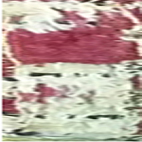
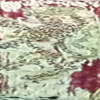

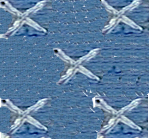
| 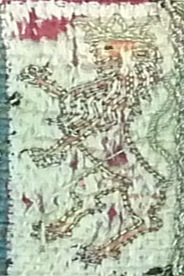
| 
| |
| Armiger's Mother's Father (conjectured) | Armiger's Mother's Mother (conjectured) | ||

| 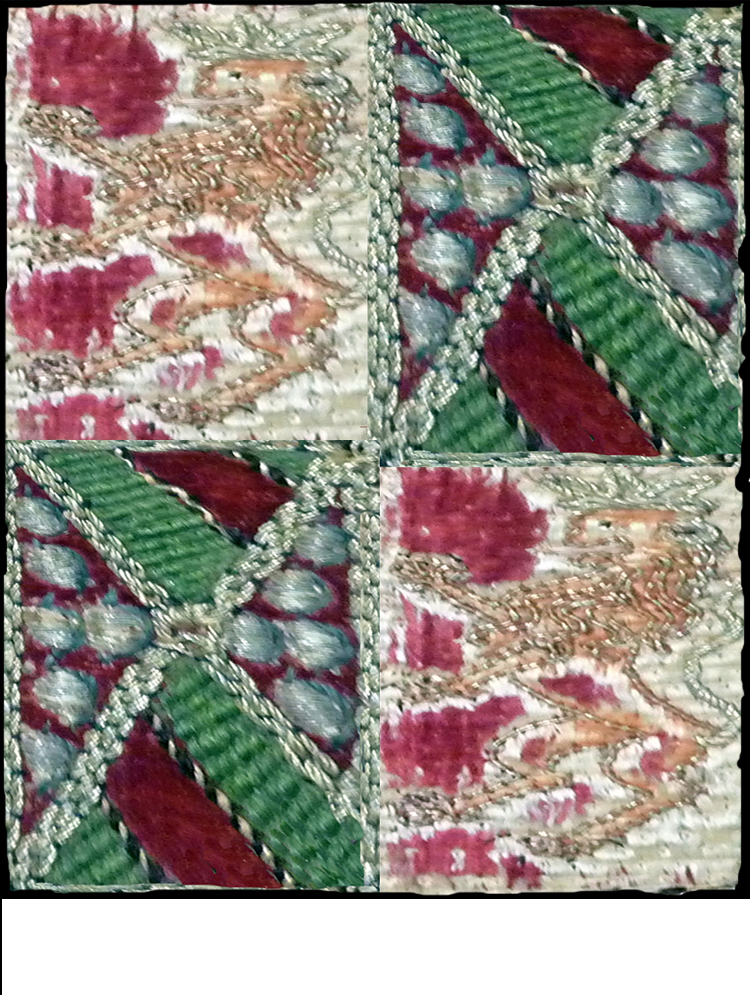
| ||
| Arms of Armiger's Mother (conjectured) | |||
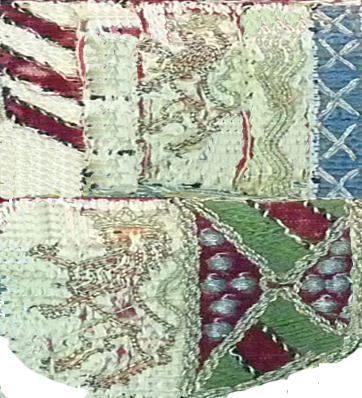
| |||
None of the conjectured arms have been found so far on monuments or in armorial manuscripts.
5. Family 5 - Argent, three bendlets gules. Arms somewhat similar to this are given in LAM, p. 235, for the King of Bosnia (barry gules and argent within a bordure Or). Associating that fairly distant kingdom with the arms on the Spanish dalmatic appears far-fetched. Nothing closer was found in the armorials.
6. Family 6 - Argent, three ?bars? Sable? Possibly the bars are checky. Possibilities include the following:
- Per LNPA, f. xvij, the arms of Soutomajor (Sotomayor) are Argent, three bars checky Or and ermine
- Per LAM, p. 170 (f. 81), the arms of Soutomaior (Sotomayor) are Argent, three bars checky Or and gules
- Per LNPA, f. xix, and per LAM, p 117 (f. 88v), the arms of Magalhães are Argent, three fess checky gules and argent of three rows.
These are the closest arms found, but none of these are close enough to be likely candidates.
7. Family 7 - Argent, a lion rampant crowned Or; that violates the rule of tincture6 See the analysis for quarter 10, which concludes that these are most likely the arms of the Kingdom of León. The conjectured child's arms postulate that this may appear as an inescutcheon on the quartered arms, since one does not descend from five grandparents. But it is unclear why they appear.
8. Family 8 - Argent, a ?tree? color? - It is uncertain if the charge is a tree at all. If it is, it could be:
- Per LNPA, f. xxxviij, and per LAM, (f. 131v) p. 110: Argent, a mulberry tree eradicated vert, arms of Picanços
Unfortunately the embroidery is too worn to be certain of the identity of the charge. "Picanços" is the Portugese name for a bird known in English as a shrike, so searches of the internet for the name tend to return articles about the bird.
9. Family 9 - Azure, five saltirelles argent. They have been moved to a more common shield position. Either way, these do not appear in any of the Spanish armorials.
10. Family 10 - The condition of the embroidery means that several blazons are possible. The most likely blazon appears to be: Argent, a lion rampant purpure, crowned Or, which are the arms of the Kingdom of Léon. This assumes:
- White threads once fully covered the background, and have been partially removed or simply worn through, thus allowing the red velvet ground to show. So while it looks like the field is divided per pale on one side of the dalmatic, it probably is not.
- Purple threads once filled the outlines of the lion, and the purple dye has faded or discolored over the last few hundred years. Purple is a fugitive dye, and within the outlines of the lion are white threads with some pale remnants of color, though it is unclear what color it might be.
11. Family of the Count of Ribadavia - Per saltire, vert and gules; on vert a bend gules fimbriated Or, and on gules semy of leaves argent; overall a saltire of chain conjoined to an orle of chain Or. AdlC, folio 105r, beside the picture of these arms, it says, "Conde de Ribadaiya. A decemtado de galizia de la casa y linaje de mendoça tiene de Renta viij V duos" = "Count of Ribadavia descended from Galicia of the house and lineage of Mendoza, has income of 8 V. ducats."
GENEALOGY OF THE MOTHER'S SIDE
The five quarters representing the five families have no clear identification, and so were not pursued further.
THE LINEAGE OF LEÓN
León was an independent kingdom on the Iberian peninsula with a line of royalty going back at least to the year 725. Alfonso IX inherited the throne of León from his father, Fernando II, and in 1197 he became the King of Castile as well when he married Berenguela, Princess of Castile. The 3 children of Alfonso and his first wife, Teresa, Princess of Portugal, became prince and princesses of León and Castile. The 5 children of his second wife, Berenguela, became princes and princesses of Castile, and their son Fernando became King of Castile. It appears that from this time forward, the Kingdom of León is bound with that of Castile, and does not have independent existence. And from that time on, the arms of the kingdom are the quartered arms of the two kingdoms of León and Castile.
Meanwhile, Alfonso had another 14 children by four other women without the benefit of marriage. These children go by the appellation "de León." The de León lines descended from the illegitimate children of Alfonso IX continued to be prominent in Spain throughout at least the 16th and 17th c. According to Reitstap, the arms of de León are "D'azur, au lion d'or", which is to say in English, "Azure, a lion Or." The armory on the dalmatic does not match this - they are much closer to León des Ourmeaux, "D'argent, au lion de gueules, armé, lampassé et couronné d'or". The latter surname does not appear in the Spanish or French genealogical site.
The Spanish genealogy website did not provide any instances of notables known as "de León y Cobos," "de León y de los Cobos," or "Cobos y de León." So tracing that pairing reached a dead end.
THE LINEAGE OF THE COUNTS OF RIBADAVIA
Looking for the family name of the line of the Counts of Ribadavia on Wikipedia led to Manuel de los Cobos y Luna, (ca 1606 - 21 June 1668), the 10th Count of Ribadavia. The family of de los Cobos includes the following people of note:
- Francisco de los Cobos y Molina (1477 - 1547), State Secretary under Carlos I. He had his portrait painted ca. 1530 by Jan Gossaert, called Mabuse; it now hangs in the Getty museum. In 1522, this 45-year-old man married the 14-year-old María de Mendoza y Sarmiento, daughter of Juan Hurtado de Mendoza y María de Sarmiento, 6th Countess of Ribadavia - this appears to be when the de los Cobos family become the Counts of Ribadavia.
- Manuel de los Cobos y Luna (ca. 1606 - 21 June 1668) had other titles as well, including Viceroy of Valencia, Viceroy of Sardinia, Grandee of Spain, Marquis of Camarasa, Duke of Sabiote, Count of Castrogeriz, Count of Villazopeque, Count of Ricla, and various lesser titles.
CONCLUSIONS
This particular combination of quartered arms does not appear in the 16th c. Spanish or Portuguese armorials consulted. However, several of the quarters are definitely from the Iberian Peninsula, so the identification of the garment as Spanish is supported by the armory.
The patrilineal line, represented by the first quarter, does not appear in this form in Renesse, and thus likely does not appear in Rietstap. From placement of royal arms on the shield, the connections of this person to royalty of the kingdoms of Navarre and León appear to be through the female line.
These arms cannot be definitively connected to a specific person at this time, though there is a slim possibility that they may be connected to Don Manuel de los Cobos y Luna, simply because he was a Duke (as the crown above the shield says), the Count of Ribadavia (as one of the quarters says), and from the de Luna lineage (from his name and as another one of the quarters says).
The only conflation of names associated with the quarterings of these arms found, was to Don Manuel de los Cobos y Luna mentioned earlier. He was also a Viceroy and Duke, so the coronet above the armory fits as well. The line of descent implied by the armory puts de Luna on the father's side, and de los Cobos on the mother's side. This does not match the line of descent implied by the structure of his surnames. And the left side of the armory, which is inherited most directly from the father, is not represented at all in Don Manuel's name. But royal connections, such as those to Navarre and León given in the armory, sometimes trump lesser nobility. So while the relationship of these arms with him is very weak, no other possibility has been found.
RESOURCES CONSULTED
ARMORIAL MANUSCRIPTS
AdlC: Armas de los Condes, Vescondes etc. de Cataluña, de Castilla, de Portugal - Bayerische StaatsBibliothek Codex Icon. 290. Spanish of 1440-1550. Available on-line at: http://daten.digitale-sammlungen.de/~db/ausgaben/thumbnailseite.html?fip=193.174.98.30&id=00001370&seite=11
LNPA: Livro da nobreza e perfeiçam das armas, facsimile of manuscript 164 of the strong room of the Torre do Tombo National Archive. Introduction, notes, artistic and graphic guidance by Martim de Albuquerque and João Paulo de Abreu e Lima, sponsored by the Academia Portuguesa da História, Lisbon, 1987. Published in Portuguese and English. Full title on the manuscript is: Livro da nobreza e perfeiçam das armas dos reis christãos e nombres linhagens dos reinos e senhorios de Portugal. Internal evidence indicates that the codex was begun before March 7, 1517, and finished sometime between 1528 and Sept 15, 1541. Also available on-line at: http://ttonline.dgarq.gov.pt/dserve.exe?dsqServer=calm6&dsqIni=imagens.ini&dsqApp=Archive&dsqDb=Images&dsqCmd=overview.tcl&dsqSearch=%28%28%28text%29%3D%27Livro%27%29AND%28%28text%29%3D%27da%27%29AND%28%28text%29%3D%27Nobreza%27%29AND%28%28text%29%3D%27e%27%29AND%28%28text%29%3D%27Perfei%E7%E3o%27%29AND%28%28text%29%3D%27das%27%29AND%28%28text%29%3D%27Armas%27%29%29
LAM: Livro do Armeiro-Mor / Livre du Grand Armurier. 1506-1509. Portugal. Available on-line at: http://ttonline.dgarq.gov.pt/dserve.exe?dsqServer=calm6&dsqIni=imagens.ini&dsqApp=Archive&dsqDb=Images&dsqCmd=overview.tcl&dsqSearch=%28%28%28text%29%3D%27Livro%27%29AND%28%28text%29%3D%27do%27%29AND%28%28text%29%3D%27Armeiro-Mor%27%29%29
Le grand armorial équestre de la Toison d'or. Manuscript BNF Arsenal 4790. French, 15th century. A photocopy of a published version with redrawn arms was consulted.
OTHER RESOURCES
Brooke-Little, J. P. "Quartering" in Coat of Arms magazine No. 17, January 1954. Available on-line at: http://www.theheraldrysociety.com/articles/marshalling_and_cadency/quartering.htm
Encyclopedia of Navarre http://www.enciclopedianavarra.net/es (in Spanish)
Renesse , comte Théodore de. Dictionnaire des figures héraldiques. (Leuven: 1992, Jan van Helmont). (in French). This is an ordinary to Rietstap, linking heraldic charges to arms, and thus to names, but does not give complete blazons. One must look up the name found here in Rietstap to get a complete blazon.
Rietstap, J. B., Armorial Général. London: Heraldry Today. 1972. (in French) Also available on the web at http://www.euraldic.com/blas_aa.html and http://archive.org/details/armorialgnra02rietuoft and a searchable version at http://www.blazonsearch.com/index.php but one must be a subscriber.
Spanish Genealogy http://www.geneall.net/ (consulted entries in Spanish, French, and Portuguese)
Wikipedia. While this is not a scholarly source, it often provides information leads and it is in English. It was consulted in the course of this investigation.
Regnal Chronologies of Iberia http://my.raex.com/~obsidian/iberia.html
I would also like to acknowledge the help given me by Bruce Miller, Robert MacHott, Christie Ward, and Keith J. Farmer in providing resources.